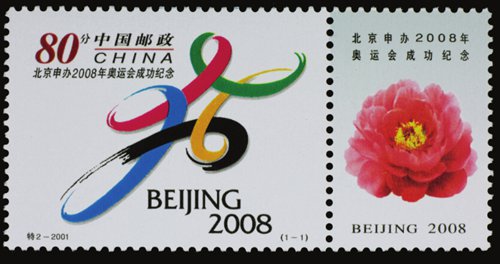
Stamps issued in 1994 in commemoration of the establishment of the special economic zones Photo: Courtesy of the China Post

"Beijing's successful bid of hosting the 2008 Olympic Games" stamp numbered as Special 2-2001 Photo: Courtesy of the China Post
The National Science Congress which was first held in Beijing from March 18 to 31, 1978 marks the beginning of China's reform and opening-up.
"Science and technology are the primary productive forces," Deng Xiaoping said. The words thundered that spring and resounded throughout the nation. China welcomed the spring of science and development, and so did China Post. Over the 40 years that followed the debut of the National Science Congress, at every significant historical moment, China Post has never been absent. Each stamp it issued has witnessed and resembled the pace of China's development.
Symbolizing 30th anniversary of the PRCOn March 18, 1978, China Post issued a set of stamps that contained three pieces in memory of the National Science Congress, which were chosen as the best stamps to mark the 30th anniversary of the establishment of the People's Republic of China (PRC). Designed by Xu Yanbo, this set of stamps contained elements like the emblem of the National Science Congress, ears of wheat, a gear, a plane and a man-made satellite, symbolizing the modernization of China's agriculture, industry, national defense and science and technology. Meanwhile, it also added the elements of red flags and atomic models, symbolizing the leap of China's science and technology in the future.
Windows to special economic zonesThe chief architect of China's reform and opening-up policy, Deng Xiaoping, said that "special economic zones are windows of technology, management, knowledge and also of foreign policy." Since the beginning of the reform and opening-up, China has established special economic zones in Shenzhen, Zhuhai and Shantou in Guangdong Province, and Xiamen in Fujian Province respectively. They were the proving grounds of China's modernization and economic development. The achievements they've made has become a legend around the world. On April 26, 1988, Hainan Province and the Hainan special economic zone were established.
China Post issued a set of stamps that contained four pieces in memory of the establishment of Hainan Province. The main pattern is the outline of Hainan's provincial map. The stamps depicted the natural scenery of Hainan Province: farmers working in the betel palm plantation near the Five Finger Mountain, the running water of the Wanquan River with coconut trees, the fantastic peaks of Tianya-Haijiao, and the forest of Luhuitou Park.
Recording big eventsAmong all types of stamps issued by China Post, common stamps, commemorative stamps and special stamps are the most widespread. On January 1, 2000, China Post issued a set of special stamps in memory of the return of Hong Kong and Macao. The two pieces are numbered 2000 - Special 1 GM. The special stamps commemorate the events that have great influence on the world. For instance, the set of stamps "Beijing's successful bid of hosting the 2008 Olympic Games" issued on July 14, 2001, is a design combining the new Beijing with the Olympics. This set was numbered as Special 2-2001. It adopted the character Te (special) before the number of the stamps, making it more recognizable.
On November 10, 2001, after 15 years of an unremitting endeavor, the PRC finally joined the World Trade Organization (WTO). It's not only the result of the establishment and improvement of China's socialist market economy, but also a reflection of China's achievement of reform and opening-up. To celebrate this significant event, China Post issued a stamp of "China to join the WTO." The stamp contained China's ornamental column, the logo of the WTO and the China World Trade Center that were linked by auspicious clouds, which symbolized the integration of China into the world's economy.





